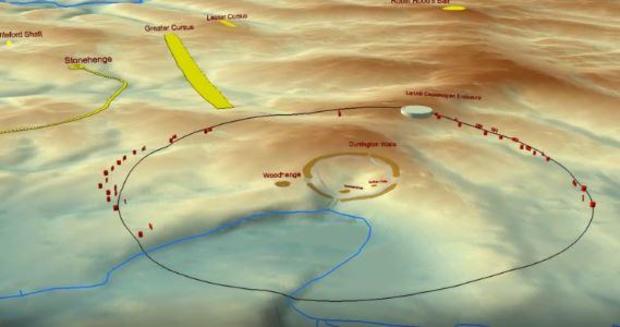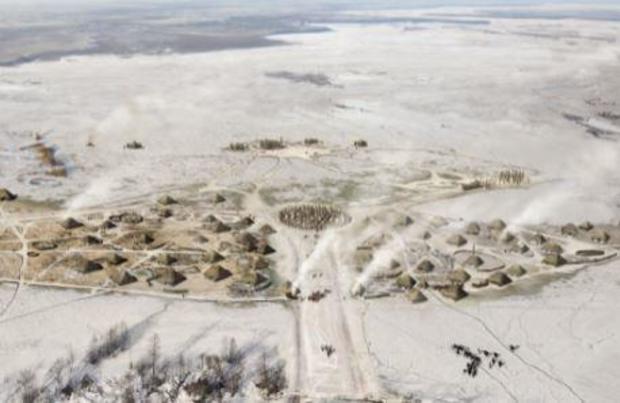Archaeologists have discovered a massive series of Neolithic-era pits very close to the Stonehenge site in southern England. As with Stonehenge itself its purpose remains a mystery, but the mere detection of the 4,000-5,000-year-old structure, on such a vast scale and so close to one of the world's most recognized prehistoric sites, has left scientists in awe.
The Stonehenge Hidden Landscapes team, a cooperative archaeological effort by a handful of British universities, found 20 of the pits altogether, forming most of a circle around the already-known, smaller Neolithic circular site known as Durrington Walls. The pits, or shafts, were each about 20 yards across and five yards deep, according to the team's research, which used a combination of high-tech imaging and traditional excavation techniques.
The "Late Neolithic Pit Structure" appears to have encircled the smaller Durrington Walls"superhenge" site, which is still a large structure compared to the familiar circle at Stonehenge. The newly discovered structure is more than a mile wide, and its relation to the other structures in the area from the same time period indicate, "an even more complex society than we could ever imagine," according to one of the scientists who led the research.
"Clearly sophisticated practices demonstrate that the people were so in tune with natural events to an extent that we can barely conceive in the modern world," Dr. Richard Bates, from St Andrews University's School of Earth and Environmental Sciences, told BBC News about the new discovery.
An animated digital map created by the research team, and shared online by the European Association of Archaeologists, shows the location of the pits in relation to Durrington Walls superhenge site, all of which sits only about two miles from Stonehenge itself.
According to the research, published in the online scientific journal Internet Archaeology, the team found manipulated flint and bone fragments in the soil near the bottom of at least one of the pits that dated it to the Late Neolithic period.
"The degree of similarity across the 20 features (pits) identified suggests that they could have formed part of a circuit of large pits around Durrington Walls," the paper says.
Professor Vincent Gaffney, one of the leading archaeologists on the Hidden Landscapes team, told The Guardian that the pits were "an unprecedented find of major significance within the U.K.," saying experts on Stonehenge and the surrounding landscape were, "taken aback by the scale of the structure and the fact that it hadn't been discovered until now so close" to the iconic stone circle.
While the nature of the site is shrouded in mystery, there's evidence that it may have remained important to humans in the region for thousands of years.
The researchers found signs in at least one of the pits suggesting it had been "recut" after the initial excavation, "suggesting that some of these features could have been maintained through to the Middle Bronze Age." That means the site may have remained relevant as humanity transitioned from the Neolithic period — the Stone Age — into the era of metalworking and the birth of large urban civilizations.
Archaeologist and author Mike Pitts, who has written extensively on Britain's prehistory, congratulated the team behind the discovery of the Durrington pit structure in a tweet, and he appeared to marvel at the scale of the discovery.
"One's immediate reaction to this is disbelief," Pitts said, "yet however hard you try to take it apart it stands up."
"As the place where the builders of Stonehenge lived and feasted, Durrington Walls is key to unlocking the story of the wider Stonehenge landscape," archaeologist Dr. Nick Snashall of the National Trust organization, which runs the Stonehenge World Heritage Site, told BBC News. "This astonishing discovery offers us new insights into the lives and beliefs of our Neolithic ancestors."
World - Latest - Google News
June 23, 2020 at 08:19PM
https://ift.tt/2CC3YvX
New Stonehenge discovery: Neolithic pit structure around Durrington Walls adds more mystery to England's pre-history - CBS News
World - Latest - Google News
https://ift.tt/2SeTG7d
Bagikan Berita Ini
















0 Response to "New Stonehenge discovery: Neolithic pit structure around Durrington Walls adds more mystery to England's pre-history - CBS News"
Post a Comment